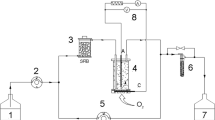Abstract
A kinetic model has been developed and kinetic parameters of anaerobic degradation of glycerol, an abundant by-product of biofuel manufacturing, by a consortium of sulfate reducing bacteria (SRB) in a closed system have been determined. The following main species of SRB has been identified in the consortium: Desulfovibrio baarsii, Desulfomicrobium sp., and Desufatomaculum sp. The proposed model included processes of glycerol degradation, sulfate reduction, and inhibition by metabolic products, as well as effects of pH and temperature. The suggested equation for the anaerobic glycerol degradation was based on Edward and Andrew’s equation. The following kinetic parameters of the anaerobic glycerol degradation were obtained for the initial glycerol concentration from 0.15 to 4 ml/l and sulfate concentration of 2760 mg/l at 22°C: maximum specific growth rate of SRB μmax = 0.56 day−1, economic coefficient of ashless biomass from glycerol of 0.08 mol SRB/mol COC, and yield of ashless biomass from sulfate of 0.020 mol SRB/mol SO4. It was shown that the optimum molar ratio of \( {{C_{Gl} } \mathord{\left/ {\vphantom {{C_{Gl} } {C_{SO_4 } }}} \right. \kern-\nulldelimiterspace} {C_{SO_4 } }} \) for SRB growth was 0.8. Initial boundary concentration of inhibition by undissociated hydrogen sulfide was 70 mg/l. Dependence of the specific growth rate of bacteria on the temperature was approximated by the Arrhenius equation in the temperature range of 20–30°C with the goodness of fit R2 = 0.99.
Similar content being viewed by others
Abbreviations
- ABM:
-
ashless biomass material
- SRB:
-
sulfate reducing bacteria
- COC:
-
chemical oxygen consumption
- dCOC:
-
difference in COC values between the unfiltered and filtered probes
- COCc :
-
chemical oxygen consumption corrected for the content of H2S in the probe
- COCF :
-
chemical oxygen consumption of the filtered probe
- ORP:
-
oxido-redox potential
- Inoc:
-
inoculum
- Gl:
-
glycerol
- NM:
-
nutrient medium
- VInoc :
-
inoculum volume
- VNM :
-
nutrient medium volume
References
Zainullin, Kh. and Smirnova, G. F., Khim. Tekhnol. Vody, 1980, no. 3, pp. 272–275.
Plahl-Wabnegg, F. and Kroiss, H., gwf-Wasser/Abwasser, 1984, vol. 125, pp. 424–426.
Dinkel, W., Frechen, F., Dinkel, B., Kljavlin, A.M., and Smirnov, Y., Electroplat. Surface Treatm., 2004, no. 3, pp. 22–28.
Hard, B.C., Friedrich, S., and Babel, W., Microbiol. Res., 1997, vol. 152, pp. 65–73.
El Bayoumy, M.A., Bewtra, J.K., Ali, H.I., and Biswas, N., Water Air Soil Pollut., 1999, vol. 112, pp. 67–84.
Weijma, J., Stams, A.J.M., Hulshoff, P.L.W., and Lettinga, G., Biotechnol. Bioeng., 2000, vol. 67.
Nagpal, S., Chuichulcherm, A., Peeva, L., and Livingston, A., Biotechnol. Bioeng., 2000, vol. 70, pp. 533–543.
Kaksonen, A.H., Franzmann, P.D., and Puhakka, J.A., Biodegradation, 2003, vol. 14, pp. 207–217.
Dijkman, H., Boonstra, J., Lawrence, R., and Buisman, J.N., in Proc. TMS 2002 Ann. Meeting, 2002.
Van Houten, R.T., Yun, S.Y., and Lettinga, G., Biotechnol. Bioeng., 1997, vol. 55, no. 5, pp. 807–814.
Moosa, S., Nemati, M., and Harrison, S.T.L., Chem. Eng. Sci., 2002, vol. 57, pp. 2773–2780.
Szewzyk, R., Untersuchungen zur Konkurrenz zwischen sulfatreduzierenden und garenden Bakterien um Gemeinsame Substrate: Diss. zur Erlengung des akademischen Grades. Konstanz, 1987.
Odom, J.M., The Sulphate-Reducing Bacteria: Contemporary Perspectives, New York: Springer-Verlag, 1993.
Nanninga, H.J. and Gottschal, J.C., Appl. Environ. Microbiol., 1987, vol. 53, no. 4, pp. 802–809.
Abw, V., Abwasserverordnung, Vom 17. 2004.
Kalyuzhnyi, S.V. and Fragoso, L., Biotekhnologicheskaya sul’fatreduktsiya v UASV-Reaktore s ispol’zovaniem etanola v kachestve donora elektronov (Biotechnological Sulfate Reduction in UASV Fermenter using Ethanol as an Electron Donor), Moscow: Martinez, Mikrobiologiya, 1997.
Varfolomeev, S.D. and Kalyuzhnyi, S.V., Biotekhnologiya: Kineticheskie osnovy mikrobiologicheskikh protsessov: Uchebn. posobie (Biotechnology: Kinetic Principles of Microbiological Processes: A Manual), Moscow: Vysshaya Shkola, 1990.
Wolf, K.H., Kinetik in Der Bioverfahrenstechnik, Hamburg: Behr, 1991.
Batstone, D.J., Keller, J., Angelidaki, I., Kalyuzhnyi, S.V., Pavlostathis, S.G., Rozzi, A., Sanders, W.T.M., Siegrist, H., and Vavilin, V.A., Anaerobic Digestion Model 1 (ADM1), IWA Task Group for Mathematical Modelling of Anaerobic Digestion Processes, London: IWA Publ., 2002.
Author information
Authors and Affiliations
Corresponding author
Additional information
Original Russian Text © V.G. Dinkel, F.B. Frechen, A.V. Dinkel, Yu.Yu. Smirnov, S.V. Kalyuzhnyi, 2009, published in Biotekhnologiya, 2009, No. 5, pp. 54–62.
Rights and permissions
About this article
Cite this article
Dinkel, V.G., Frechen, F.B., Dinkel, A.V. et al. Kinetics of anaerobic biodegradation of glycerol by sulfate-reducing bacteria. Appl Biochem Microbiol 46, 712–718 (2010). https://doi.org/10.1134/S0003683810070069
Received:
Published:
Issue Date:
DOI: https://doi.org/10.1134/S0003683810070069




